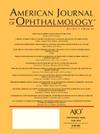视力不良事件与Pegcetacoplan和Avacincaptad Pegol治疗地理萎缩相关:一项基于人群的药物警戒研究:Pegcetacoplan和Avacincaptad Pegol的眼部不良事件。
IF 4.1
1区 医学
Q1 OPHTHALMOLOGY
引用次数: 0
摘要
目的评价avacincaptad pegol和pegcetacoplan上市后眼部不良事件(ae),这两种药物是美国食品药品监督管理局(FDA)唯一批准的治疗地理萎缩(GA)的药物。设计回顾性队列研究(药物警戒分析)。对FDA不良事件报告系统(FAERS)中pegcetacoplan或avacincaptad pegol被确定为主要可疑药物的报告进行了分析。方法采用OpenVigil 2.1数据挖掘软件,对FAERS数据库自成立至2024年12月的药物警戒情况进行回顾性分析。我们进行了歧化分析,以评估与数据库中所有其他药物相比,特定药物- ae组合的报告优势比(RORs)。主要结果测量:视觉ae。结果分别有752例和80例pegol继发于pecetacoplan和avacincaptad pegol的ae。pegcetacoplan过度报道的眼部不良事件包括前段(虹膜)出血(ROR=1767, 95% CI=538 ~ 5803)、虹膜新生血管(ROR=1248, 95% CI=502 ~ 3099)、脉络膜新生血管(ROR=1328, 95% CI=956 ~ 1845)、眼内注射并发症(ROR=2552, 95% CI=1607 ~ 4053)、出血性视网膜闭塞性血管炎(ROR=4606, 95% CI=2000 ~ 10611)、视网膜闭塞性血管炎(ROR=2352, 95% CI=1313 ~ 4212)和细菌性眼内炎(ROR=1260,95% CI=613 ~ 2589)。因无captpegol而被过度报道的眼部ae包括脉络膜新生血管(ROR=1169, 95% CI=426 ~ 3205)、玻璃体炎(ROR=782, 95% CI=316 ~ 1936)、干性年龄相关性黄斑变性(ROR=684, 95% CI=316 ~ 1936)和囊状黄斑水肿(ROR=445, 95% CI=140 ~ 1412)。结论基于目前的处方模式,pegcetacoplan的眼部ae谱比pegol更广。这些发现旨在提高临床医生对这些药物安全性的理解,使患者得到知情的护理,并提高对这些新型GA治疗的警惕。本文章由计算机程序翻译,如有差异,请以英文原文为准。
Ocular Adverse Events Associated with Pegcetacoplan and Avacincaptad Pegol for Geographic Atrophy: A Population-Based Pharmacovigilance Study: Ocular Adverse Events of Pegcetacoplan & Avacincaptad Pegol.
OBJECTIVE
To evaluate the post-marketing ocular adverse events (AEs) associated with avacincaptad pegol and pegcetacoplan, the only Food and Drug Administration (FDA)-approved treatments for geographic atrophy (GA).
DESIGN
Retrospective cohort study (pharmacovigilance analysis).
SUBJECTS
AE reports in the FDA Adverse Event Reporting System (FAERS) in which pegcetacoplan or avacincaptad pegol were identified as the primary suspect drugs were analyzed.
METHODS
Using the OpenVigil 2.1 data mining software, we conducted a retrospective pharmacovigilance analysis of the FAERS database from inception to December 2024. We conducted disproportionality analyses to assess reporting odds ratios (RORs) for specific drug-AE combinations compared to all other drugs in the database.
MAIN OUTCOME MEASURES
Ocular AEs.
RESULTS
A total of 752 and 80 patients with AEs secondary to pegcetacoplan and avacincaptad pegol, respectively, were identified. Ocular AEs disproportionately overreported for pegcetacoplan included anterior segment (iris) hemorrhage (ROR=1767, 95% CI=538 to 5803), iris neovascularization (ROR=1248, 95% CI=502 to 3099), choroidal neovascularization (ROR=1328, 95% CI=956 to 1845), intraocular injection complication (ROR=2552, 95% CI=1607 to 4053), hemorrhagic occlusive retinal vasculitis (ROR=4606, 95% CI=2000 to 10611), retinal occlusive vasculitis (ROR=2352, 95% CI=1313 to 4212), and bacterial endophthalmitis (ROR=1260, 95% CI=613 to 2589). Ocular AEs disproportionately overreported for avacincaptad pegol included choroidal neovascularization (ROR=1169, 95% CI=426 to 3205), vitritis (ROR=782, 95% CI=316 to 1936), dry age-related macular degeneration (ROR=684, 95% CI=316 to 1936), and cystoid macular edema (ROR=445, 95% CI=140 to 1412).
CONCLUSIONS
Based on current prescribing patterns, a broader spectrum of ocular AEs were reported for pegcetacoplan than avacincaptad pegol. These findings aim to enhance clinicians' understanding of the safety profiles of these agents, enabling informed patient care and heightened vigilance of these novel GA treatments.
求助全文
通过发布文献求助,成功后即可免费获取论文全文。
去求助
来源期刊
CiteScore
9.20
自引率
7.10%
发文量
406
审稿时长
36 days
期刊介绍:
The American Journal of Ophthalmology is a peer-reviewed, scientific publication that welcomes the submission of original, previously unpublished manuscripts directed to ophthalmologists and visual science specialists describing clinical investigations, clinical observations, and clinically relevant laboratory investigations. Published monthly since 1884, the full text of the American Journal of Ophthalmology and supplementary material are also presented online at www.AJO.com and on ScienceDirect.
The American Journal of Ophthalmology publishes Full-Length Articles, Perspectives, Editorials, Correspondences, Books Reports and Announcements. Brief Reports and Case Reports are no longer published. We recommend submitting Brief Reports and Case Reports to our companion publication, the American Journal of Ophthalmology Case Reports.
Manuscripts are accepted with the understanding that they have not been and will not be published elsewhere substantially in any format, and that there are no ethical problems with the content or data collection. Authors may be requested to produce the data upon which the manuscript is based and to answer expeditiously any questions about the manuscript or its authors.

 求助内容:
求助内容: 应助结果提醒方式:
应助结果提醒方式:


